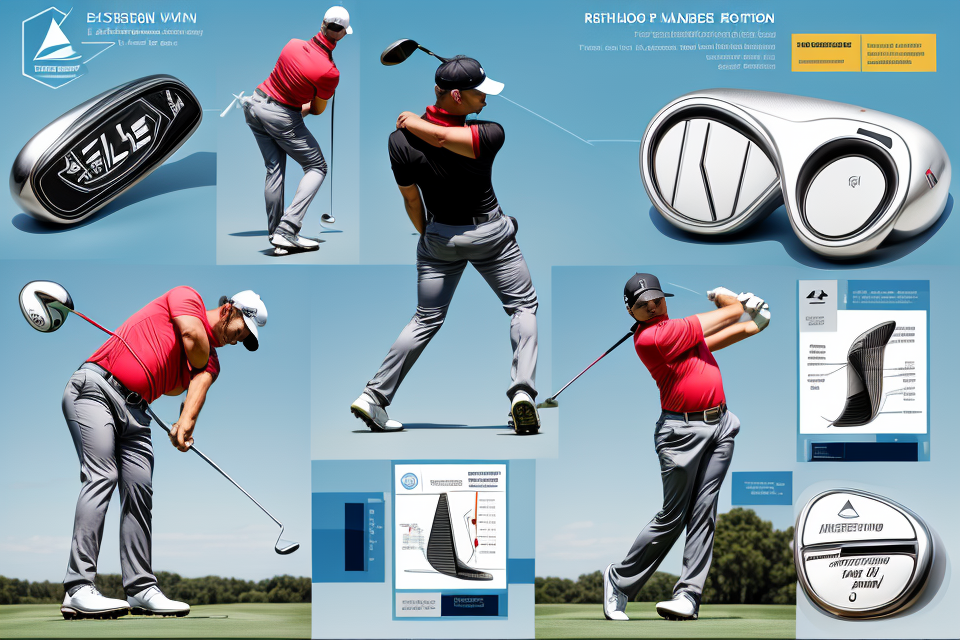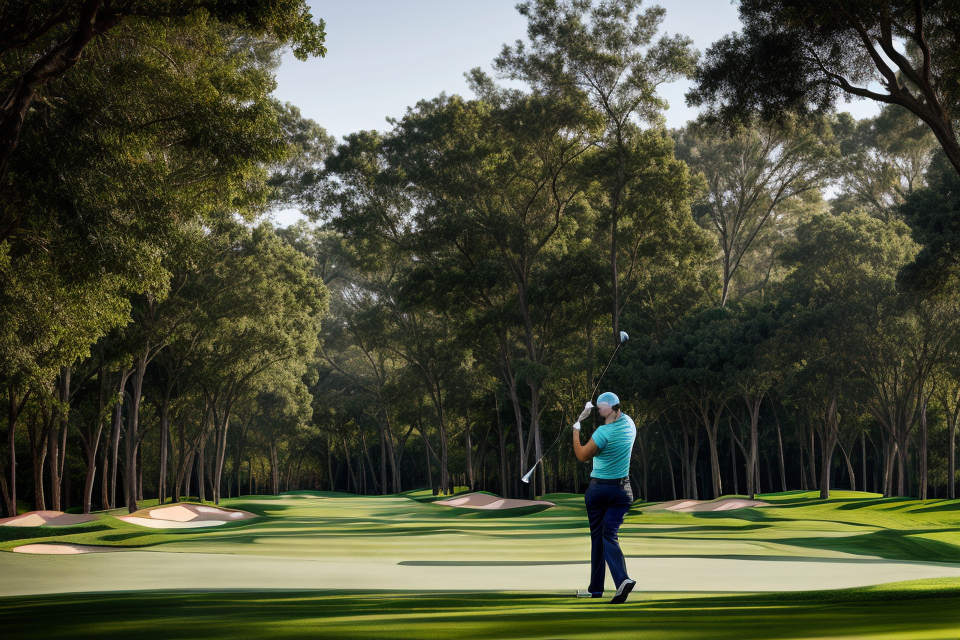
Golf club technology has come a long way in recent years, with the development of new materials and designs. But what exactly is CG and Moi in golf club technology? In simple terms, CG stands for “center of gravity,” which refers to the point where the majority of an object’s mass is concentrated. In golf clubs, this means the location where the majority of the weight is located. Moi, on the other hand, refers to the measurement of the club’s dynamic properties, including its flexibility and stiffness. In this article, we will delve deeper into the world of CG and Moi in golf club technology, exploring how these concepts impact the performance of golf clubs and how they can be used to improve your game. Whether you’re a seasoned pro or a beginner, understanding these concepts can give you a competitive edge on the course. So, let’s get started!
CG, or “center of gravity,” refers to the location where the weight of an object is concentrated. In golf club technology, the CG is important because it affects the club’s performance and how it responds to the golfer’s swings. The lower the CG, the easier it is to launch the ball and the farther it will go. Moi, on the other hand, refers to the relationship between the club’s weight and its overall design. A lower Moi means that the clubhead is more compact and has a lower center of gravity, which can lead to improved accuracy and distance control. Overall, both CG and Moi play important roles in golf club technology, as they can significantly impact the performance of the club and the golfer’s ability to hit the ball accurately and with power.
What is CG in Golf Clubs?
How is CG Measured in Golf Clubs?
Measuring the Center of Gravity (CG) in golf clubs is an essential aspect of golf club technology. It refers to the location where the bulk of the club’s weight is concentrated. The CG of a golf club influences its performance, including its trajectory, spin rate, and overall distance. Understanding how to measure CG accurately is crucial for golf club manufacturers, fitters, and golfers alike.
There are two primary methods for measuring CG in golf clubs:
- Using a CG machine
- Measuring the distance from the center of the shaft to the CG
Using a CG machine
A CG machine is a specialized piece of equipment designed to measure the distribution of weight in a golf club. This machine typically consists of a base plate and a pivoting arm, which holds the golf club in place. The machine uses sensors to measure the weight of the club at various points along its length, allowing the CG to be calculated.
CG machines are precise and accurate, providing detailed information about the location of the CG in a golf club. They are commonly used by golf club manufacturers and fitters to optimize club designs and ensure that each club performs consistently.
Measuring the distance from the center of the shaft to the CG
An alternative method for measuring CG in golf clubs is to measure the distance from the center of the shaft to the CG. This method involves calculating the distance from the center of the grip end of the shaft to the center of the clubhead. The CG is typically located near the geometric center of the clubhead, which is the point where the two perpendicular axes intersect.
This method is less precise than using a CG machine, but it can still provide useful information about the location of the CG in a golf club. It is often used by golfers who want to understand the impact of different club configurations on their performance. By adjusting the clubhead size, shape, or weight, golfers can alter the CG and optimize their club’s performance for their individual swing.
What is the Ideal CG Location in Golf Clubs?
- The concept of CG, or center of gravity, is a crucial aspect of golf club technology. It refers to the point at which the weight of the club is evenly distributed, influencing its balance and performance.
- The ideal CG location in golf clubs can vary depending on the specific club and the golfer’s swing style. Generally, a low and back CG location is considered ideal for greater stability and accuracy. This is because a lower CG allows for a more stable, penetrating ball flight, reducing the impact of external factors such as wind and turf interaction. Additionally, a back CG location promotes a more neutral or draw ball flight, which is preferred by many golfers for improved accuracy.
- However, for certain clubs, such as drivers and fairway woods, a slightly forward CG location can be beneficial for increasing power and distance. This is because a forward CG promotes a higher, more ball-focused CG at impact, leading to increased ball speed and distance. The trade-off, however, is that a forward CG location may also increase the risk of slicing or hooking for some golfers, depending on their swing characteristics.
- In summary, the ideal CG location in golf clubs depends on the specific club and the golfer’s swing characteristics. A low and back CG location is generally preferred for stability and accuracy, while a slightly forward CG location can provide increased power and distance. Golf club manufacturers and custom fitters utilize advanced technologies and techniques, such as 3D modeling and robotic testing, to optimize CG locations for optimal performance.
How does CG Affect Ball Flight?
Higher CG leads to higher trajectory and less spin
In golf club technology, the higher the CG (center of gravity), the higher the trajectory of the ball flight. This occurs because the higher CG causes the clubhead to move faster through the ball, resulting in more kinetic energy being transferred to the ball. The increased kinetic energy leads to a higher initial velocity, which results in a higher trajectory. Additionally, the higher trajectory results in less spin, as there is less friction between the ball and the air, which reduces the amount of spin imparted to the ball.
Lower CG leads to lower trajectory and more spin
On the other hand, a lower CG in golf clubs leads to a lower trajectory and more spin. This occurs because the lower CG causes the clubhead to move slower through the ball, resulting in less kinetic energy being transferred to the ball. The decreased kinetic energy leads to a lower initial velocity, which results in a lower trajectory. Additionally, the lower trajectory results in more spin, as there is more friction between the ball and the air, which increases the amount of spin imparted to the ball.
In summary, the CG of a golf club affects the trajectory and spin of the ball flight. A higher CG leads to a higher trajectory and less spin, while a lower CG leads to a lower trajectory and more spin.
What is Moi in Golf Clubs?
What is Moi Measurement in Golf Clubs?
Moi measurement is a process used to determine the weight and balance of a golf clubhead. It is an important factor in golf club technology as it can affect the club’s performance and the golfer’s swing. The measurement is typically taken using a specialized machine called a Moi machine.
The Moi machine is designed to accurately measure the weight and balance of a golf clubhead. It works by suspending the clubhead from a pivot point and measuring its resistance to movement. This allows the machine to determine the clubhead’s moment of inertia (MoI), which is a measure of its resistance to rotation.
There are several factors that can affect a golf club’s MoI, including the weight and position of the clubhead’s center of gravity (CG). The CG is the point where the clubhead’s weight is concentrated, and it can affect the club’s stability and trajectory during the swing.
Measuring the MoI of a golf club can help golf club manufacturers and fitters optimize the design and construction of the clubhead to improve its performance. It can also help golfers select the right club for their swing and playing style.
Overall, Moi measurement is an important tool in golf club technology that can help improve the performance of golf clubs and enhance the golfer’s experience on the course.
What is the Ideal Moi in Golf Clubs?
The moment of inertia (MOI) in golf clubs refers to the resistance of a clubhead to twisting or rotating during a swing. It is a measure of the clubhead’s stability and predictability, which is crucial for accuracy and power.
When it comes to the ideal MOI in golf clubs, there are different opinions and preferences among golfers and experts. However, generally speaking, there are two common ideal MOI positions for golf clubs:
Neutral or Slightly Toe-Down MOI
A neutral or slightly toe-down MOI is considered ideal for greater stability and accuracy. This position provides a more neutral and balanced feel during the swing, reducing the risk of twisting or rotating excessively. As a result, golfers can maintain a more consistent ball flight and direction, which is essential for hitting the target accurately.
Heel-Shafted MOI
On the other hand, a heel-shafted MOI is preferred for increased power and distance. This position shifts the center of gravity (CG) further away from the shaft, which generates a more explosive and powerful swing. The heel-shafted MOI allows golfers to maximize their swing speed and power, resulting in longer shots and greater distance.
However, it is important to note that the ideal MOI position also depends on the golfer’s swing type and preferences. Some golfers may prefer a more neutral or toe-down MOI for better control and accuracy, while others may opt for a heel-shafted MOI for more power and distance. Ultimately, finding the ideal MOI position requires proper fitting and testing to ensure that it matches the golfer’s individual swing characteristics and preferences.
How does Moi Affect Ball Flight?
Moi, short for “moment of inertia,” is a measure of a golf club’s resistance to twisting or rotating around its axis. The higher the moi, the more resistant the club is to twisting.
When it comes to ball flight, moi plays a significant role in determining the trajectory and spin of the ball.
- Higher Moi leads to higher trajectory and less spin: A golf club with a higher moi will be less affected by the force of gravity, resulting in a higher trajectory and less spin on the ball. This means that the ball will travel further and straighter.
- Lower Moi leads to lower trajectory and more spin: A golf club with a lower moi will be more affected by the force of gravity, resulting in a lower trajectory and more spin on the ball. This means that the ball will travel shorter distances and have a higher probability of curving or slicing.
Understanding how moi affects ball flight can help golfers choose the right clubs for their swings and adjust their techniques to achieve the desired ball flight.
Optimizing CG and Moi for Your Game
How to Adjust CG and Moi for Improved Performance
One of the most important aspects of optimizing your golf club technology is adjusting the CG (center of gravity) and moi (moment of inertia) for improved performance. Here are some tips on how to do just that:
Changing shaft weights
One way to adjust the CG and moi of your golf clubs is by changing the shaft weights. By using heavier or lighter shafts, you can move the CG closer or farther away from the hosel, which can affect the ball flight and spin. For example, if you want to lower the CG and increase the moi, you can use a heavier shaft with a lower kick point. On the other hand, if you want to raise the CG and decrease the moi, you can use a lighter shaft with a higher kick point.
Using different clubhead designs
Another way to adjust the CG and moi is by using different clubhead designs. For example, if you want to lower the CG and increase the moi, you can use a clubhead with a deeper face or a larger sweet spot. This will help you launch the ball higher and spin it less. On the other hand, if you want to raise the CG and decrease the moi, you can use a clubhead with a shallower face or a smaller sweet spot. This will help you launch the ball lower and spin it more.
Adjusting grip and stance
Finally, you can adjust the CG and moi of your golf clubs by adjusting your grip and stance. By adjusting your grip, you can change the angle of attack and affect the ball flight and spin. For example, if you want to lower the CG and increase the moi, you can use a stronger grip or a more neutral grip. On the other hand, if you want to raise the CG and decrease the moi, you can use a weaker grip or a more laid-off grip. By adjusting your stance, you can also affect the CG and moi of your golf clubs. For example, by standing closer to the ball or farther away from the ball, you can change the CG and affect the ball flight and spin.
Importance of CG and Moi in Custom Fitting
When it comes to improving your golf game, custom fitting is an essential aspect that cannot be overlooked. One of the most important factors in custom fitting is understanding the position of the center of gravity (CG) and the moment of inertia (MOI) of your golf clubs.
Understanding your swing and preferences
The position of the CG and MOI of your golf clubs can have a significant impact on your swing and overall performance on the course. For example, if the CG of your driver is too far forward, it may cause you to slice the ball. On the other hand, if the CG is too far back, you may experience a push or a push-slice.
To find the best fit for your game, it is essential to understand your swing and preferences. A professional fitter can analyze your swing using launch monitor technology and provide you with a detailed report of your ball flight tendencies. This information can help you and your fitter determine the optimal CG and MOI settings for your clubs.
Finding the best fit for your game
The best fit for your game will depend on several factors, including your swing speed, ball speed, spin rate, and launch angle. By analyzing your ball flight tendencies and understanding your preferences, a professional fitter can help you find the best fit for your game.
For example, if you have a slower swing speed, you may benefit from a driver with a higher MOI, which will help you keep the ball in play. If you have a faster swing speed, you may benefit from a driver with a lower MOI, which will allow you to generate more distance.
Increasing your consistency and performance on the course
When you have the right combination of CG and MOI in your golf clubs, you can expect to see an improvement in your consistency and performance on the course. With the right custom fit, you can reduce your slice, increase your distance, and improve your overall accuracy.
By working with a professional fitter, you can find the best fit for your game and take your golf game to the next level. So, whether you are a beginner or an experienced golfer, it is essential to consider the importance of CG and MOI in custom fitting and how it can help you improve your game.
FAQs
1. What does CG stand for in golf club technology?
Answer:
CG stands for “center of gravity.” In golf club technology, the CG refers to the point where the majority of the weight of the clubhead is concentrated. The CG affects the club’s balance, feel, and performance. The lower the CG, the higher the ball will fly, and the more forgiving the club will be on off-center hits.
2. What is Moi in golf club technology?
Moi is a term used in golf club technology to describe the relationship between the clubhead and the shaft. It refers to the angle between the shaft axis and the vertical plane, which affects the club’s stability and control during the swing. A higher Moi means a more stable clubhead, while a lower Moi means a more maneuverable clubhead.
3. How does the CG affect the performance of a golf club?
The CG is a critical factor in determining the performance of a golf club. A lower CG means that the clubhead will be more stable and forgiving on off-center hits, resulting in more consistent ball flights and greater accuracy. Additionally, a lower CG can help increase the clubhead speed and ball velocity, resulting in longer drives and more stopping power on approach shots.
4. How is the Moi of a golf club determined?
The Moi of a golf club is determined by the angle between the shaft axis and the vertical plane. This angle can be measured using specialized equipment and software or calculated using formulas that take into account the clubhead and shaft dimensions. The Moi can also be adjusted by changing the shaft weight, the clubhead design, or the swingweight of the club.
5. What are the benefits of a higher Moi in a golf club?
A higher Moi in a golf club means that the clubhead is more stable and resistant to twisting during the swing. This can result in improved accuracy and control, especially on long shots and high-speed swings. Additionally, a higher Moi can help reduce the effects of unwanted head movements, such as slicing or hooking, and promote a more consistent ball flight.


